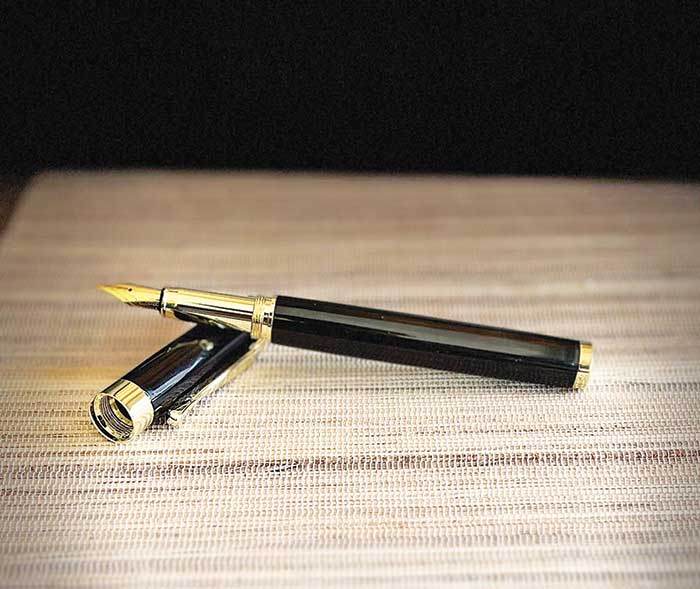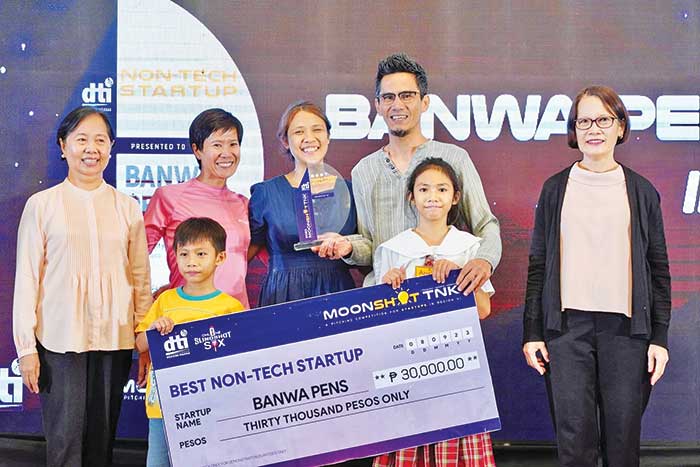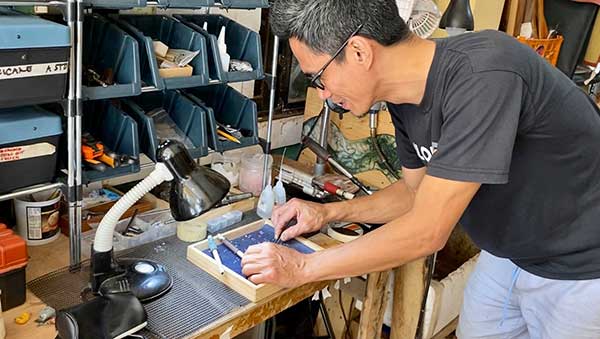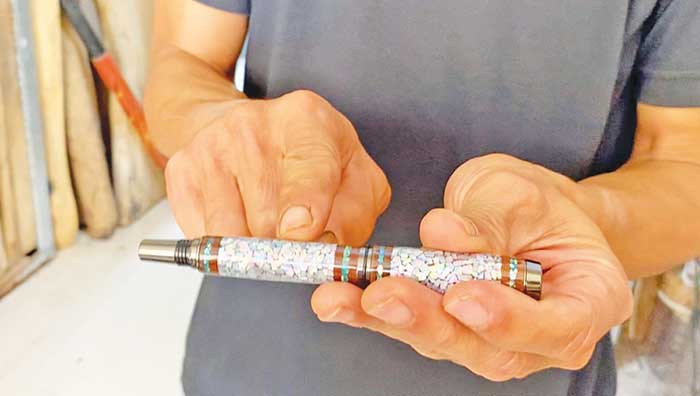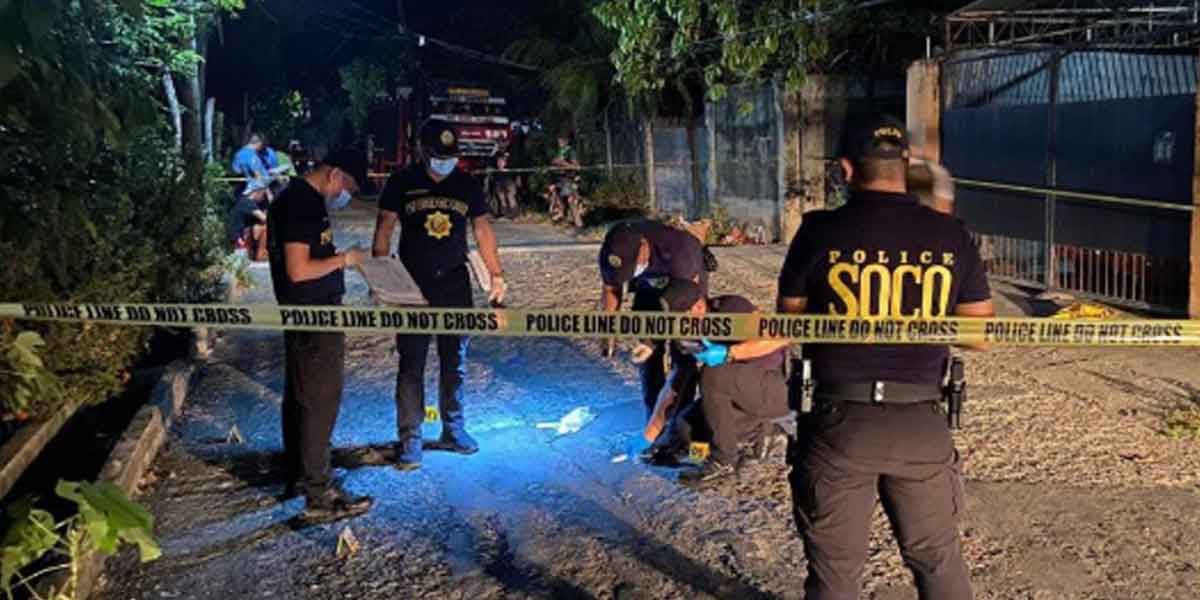By Mariela Angella Oladive
The pen, throughout history, has long proven its power. Quoting the famous saying, “The pen is mightier than the sword,” most of us at least know one story about how a pen has changed the world.
This time, let us tell the story of an Ilonggo making a change through pen-making, and find out how, with a single pen, there can be a personal and a story of the banwa (community) waiting to be told or perhaps also to be held.
Starting from the ‘Banwa’
Much more than a mere writing tool, Banwa pens are an embodiment of community, craftsmanship, and a visionary pursuit. The name Banwa pens itself carries a profound meaning.
Arnel John “Nonoy” Vallejo, a native of Duenas, Iloilo, and the founder of Banwa pens, said in an interview with Daily Guardian that the term “banwa,” or community in the local dialect, served as the inspiration for the name of his brand.
Vallejo emphasized that the essence of community was what he envisioned for te Banwa pens.
“My vision for Banwa pens is actually very ambitious. So, I really want to make it a community where the people, artisans, and entrepreneurs collaborate,” he said while sharing his active engagement in partnerships, like his current collaboration with Panay Bukidnon for the pen’s handwoven sleeves.
He is also working with a fellow Duenasanon, Ariel Pulmones, an entrepreneur focusing on wood engraving, who is instrumental in creating the intricate engravings on banwa pens‘ wooden cases. He is also planning to tap local leather makers to make Banwa pen leather cases.
“We are aiming for a world class quality,” Vallejo noted.
Founding the ‘Banwa’
Founded in 2019, Banwa Pens began as a personal exploration into woodworking. Vallejo before making wood pens is already into wood crafting starting with humble projects like DIY items, chairs, and tables. His pen-making journey was sparked by a suggestion from his uncle.
Initially hesitant, Vallejo first ventured into making calligraphy pens, inspired by his wife’s love for calligraphy.
“My wife, who is still fond of calligraphy, used to purchase calligraphy pens online, but they are expensive, also there’s an additional shipping fee. At that time, there were no locally made calligraphy [dip] pens available in the Philippines, and while there used to be some imports, they eventually became scarce,” Vallejo narrated.
“That’s when the idea of making pens sparked my interest. I started with calligraphy pens, driven not by a business in mind, but by my passion for the craft, especially as the calligraphy pen trend had dwindled in the Philippines. Despite the trend shift, my focus remained on doing it because I genuinely loved the craft,” Vallejo added.
Going beyond the calligraphy pen, Vallejo later ventured into making ball pens, gel pens, and fountain pens.
Out to the Banwa
From posting his pens on Instagram, Vallejo’s creations slowly garnered attention not just locally but from across the country.
The turning point came when Vallejo acquired a wood lathe machine from China in 2020, allowing him to refine his craft and fully delve into the world of pen making sharing that the pandemic also gave him time to focus on honing his skills.
“Right after the pandemic, here comes the Fresh Find Exhibit held by PCCI at Festive Walk Iloilo. Someone asked me if I could display my work, and I did so. From there, a lot of people got to see my work, and they appreciated it,” shared Vallejo.
From then on, Banwa pens started to join several local exhibits and even joined the recent Department of Trade and Industry (DTI) 6’s 2023 Moonshot TNK Startup Pitching Competition held September 8 at District 21 Hotel in Iloilo City, where it clinched the Best Non-Tech Startup category award, receiving a plaque of recognition and PHP30, 000.00 prizes, which marked a significant milestone for the Banwa Pens.
Crafted with precision: The Art of Banwa Pens
What sets Banwa Pens apart, other than the meticulous and skillful craftsmanship, is the passionate labor that goes into each piece, making it more than just a writing instrument but a meaningful piece of art. It distinguishes itself by focusing on custom work and not gearing towards mass production.
“Since I am a one-man army, I want to focus on custom work. I want to give exactly what the client wants. It’s their pen, it’s their ideas. I am only an instrument in turning their ideas into reality,” said Vallejo, further underscoring the beauty of custom work– it being distinct and personal.
“If I am going to mass produce it, it might not capture that meaning,” he added.
While the aesthetic appeal of Banwa Pens not only settles into its visual aspect but in the tangible experience of holding it.
Vallejo emphasizes the need to witness the pens in person to fully appreciate them, to feel their shiny texture, their weight, the balance, and every other little detail, such as the wood pattern and the glittering small pieces of shells puzzled together in the barrel of the pen.
“In making the pen, I assemble it. There’s a tube and other parts of a pen, so what I do is I make a body out of wood [using wood-turning] until I turn it into a finished product,” explained Vallejo.
The process of making a wood pen is both captivating and intricate. From wood preparation to designing and shaping the pen, it requires time and great attention to detail.
All Banwa pens are refillable, and depending on the intricacy of the design, making banwa pens takes time.
Making it the Filipino Pen
With a goal of using Philippine local woods in a different form, Vallejo highlights his commitment to making a Filipino pen, while having sustainable practices at the forefront.
“The way I make the pens, I focus on making it a Filipino pen where the heart of every Filipino is there. So, I focus on locally sourced woods,” he stated further telling about how he only used retaso or discarded wood from the furniture shops.
While the longevity of Banwa Pens primarily depends on the user, Vallejo guarantees the use of durable woods, each offering unique characteristics and aesthetics.
Some popular types of wood Banwa Pens use include, Sibukao, which is one of the best fuelwood species found in the Visayas region. Mangkono, also known as the Philippine ironwood, is the hardest tree in the country and is an endangered endemic tree valued for its extremely durable and pest-resistant attributes. Mahogany presents a reddish-brown color, while Narra is the Philippine national tree. Other types of wood used by Banwa Pens include Acacia, Gmelina, and Kamagong, among others.
Carving pen stories
From repurposing the regulated tree Mangkono that fell during Typhoon Odette sent to Vallejo by a friend, to using 100-year-old Molave wood from an ancestral house, Banwa Pens carved stories into each pen.
Vallejo recounted touching stories of clients who entrusted him with precious wood materials, which he turned into pens that evoke nostalgia and are intended as keepsakes.
“I have one client who gave me a 100-year-old Molave wood part of their ancestral house. As a thank-you gift, to her surprise, I made a pen out of it, and she got teary-eyed. It brings back memories kon makita nya ang pen. I also have a client who asked me to make a pen to be passed from generation to generation like an heirloom,“ he narrated.
Among the notable persons who have received Banwa pens were former Vice President Leni Robredo, First Lady Atty. Marie Louise Araneta Marcos, Iloilo City Mayor Jerry Trenas, OWWA administrator Arnel Ignacio, while the pen has also reached customers overseas like someone from Canada, Korea, and Dubai.
Pen-making a change
According to Vallejo, while pen-making has a long history globally, “it is something new in Iloilo.” He recognized this as an opportunity to not just create pens but to pursue excellence in his craft.
“This is my way of taking Iloilo to the next level,” he declared.
His focus shifted from a hobby to a passion-driven commitment to produce pens of the highest quality, thus leading to the branding of Banwa Pens.
Looking ahead, Banwa Pens aspires to expand and contribute to the community further. Vallejo’s plans include conducting workshops for the youth and building spaces dedicated to carpentry, bringing recognition to the often-overlooked labor behind wood crafts.
As Banwa Pens gains recognition not only locally but also on a global scale, Vallejo’s dedication extends beyond the individual creations; he envisions Banwa Pens as a way to uplift others mirroring his vision of the ‘community’ which is working together while making a pen that holds not just a single story, but a story of an old age tree, and most importantly the story of ‘banwa’.



















